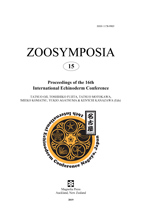Abstract
Three sympatric species of temnopleurid sea urchins, Temopleurus toreumaticus (Leske, 1778), T. hardwickii (Gray, 1855) and Mespilia globulus (Linnaeus, 1758), occupy a habitat located a short distance from the shore of the Seto Inland Sea, Yamaguchi Prefecture, Japan. Breeding seasons overlap considerably among these species. These species exhibit species-specific differences in embryonic and larval development such as a wrinkled zygote, wrinkled blastula, archenteron invagination, larval skeleton and juvenile morphology. In this study, we determined whether interbreeding among these species is possible. Investigations revealed that fertilization succeeded with all mating combination patterns and that all fertilized eggs developed to the gastrula stage. The blastula and gastrula of hybrids formed in a manner similar to the maternal whereas the developmental delay observed followed the pattern of the paternal species T. toreumaticus fertilized at a greater proportion than other pairs and metamorphosed. These results suggest that eggs of this species may have weaker fertilization block in general. At the early developmental stages, hybrid embryos from T. toreumaticus mothers express maternal, while some hybrids derived from sperm of T. toreumaticus and the eggs of other species ceased development at the 4-armed larval stage. The hybrids of T. hardwickii and M. globulus ceased development at the gastrula stage, suggesting that these species have a greater degree of genetically isolation distance. In hybrids of T. toreumaticus and strongylocentrotid Hemicentrotus pulcherrimus (A. Agassiz, 1864), larval skeletons expressed features from both species. These results suggest that traits of hybrids are derived not only from one or both original species, but that a mosaic effect can be obtained depending on the traits. These results indicate that temnopleurids have the weaker fertilization block mechanisms. Isozyme analyses showed that hybrid prisms of T. toreumaticus eggs and M. globulus sperm possess enzymatic patterns of malate dehydrogenase derived from each parent, whereas the enzymatic pattern of glucose-6-phosphate dehydrogenase is derived from eggs, suggesting that malate dehydrogenase activity may be useful in detecting naturally occurring adult hybrids among these species in the Yamaguchi coastal area.

